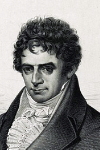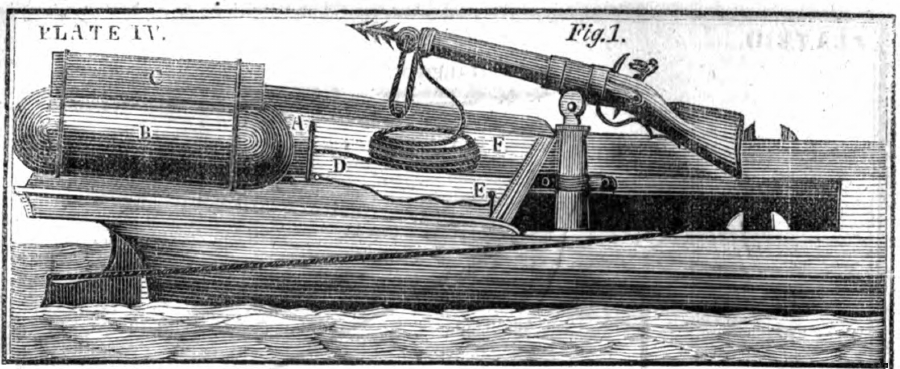 While researching Samuel Colt’s experiments with mines at the Washington Navy Yard, I came across the statement that “Robert Fulton conducted research and testing on his clockwork torpedo during the War of 1812.” Since numerous sources use this exact wording, it probably comes directly from the Navy. Obviously, this is exactly the sort of historical event that I am always pleased to look into.
While researching Samuel Colt’s experiments with mines at the Washington Navy Yard, I came across the statement that “Robert Fulton conducted research and testing on his clockwork torpedo during the War of 1812.” Since numerous sources use this exact wording, it probably comes directly from the Navy. Obviously, this is exactly the sort of historical event that I am always pleased to look into.
Unfortunately, this statement appears to be more than a little overoptimistic. The “research” part may be correct; the “testing” is most likely not.
Robert Fulton (pic) did indeed try to invent new ways of blowing up ships from below their waterline. In fact, in 1805 he destroyed a 200-ton ship, the “Dorothea” in England. However, six days later, Admiral Nelson won the battle of Trafalgar, and the need for mines by the British evaporated along with the Franco-Spanish fleet. Fulton thus returned to the United States to attempt to sell his idea.
In early 1807, he came to Washington, where he pushed patent reform and celebrated Lewis and Clark. He also found the time to collect money to do another experiment, this time in New York harbor. While the test was reasonably successful, he soon returned to his work on the steam engine powered ships.
Two years later, in February 1809, Fulton returned to Washington to make another effort to build his destructive devices. This time, he was attempting to not only set explosives underneath ships, but to deliver them via a harpoon and rope combination – essentially a forerunner to today’s torpedoes. On February 12th, he had a gathering at his friend Joel Barlow’s house, Kalorama. Invited were both Thomas Jefferson and James Madison, current President, and President-elect, respectively.
A year later, Fulton wrote a paper to the Senate entitled “Use of the Torpedo in the Defence of Ports and Harbors” in which he described not only his torpedo, but also explained how cost-effective a solution it was. While the paper contained an impressive array of numbers, it was unclear how they added up to a true cost savings. Whatever its shortcomings, the paper spurred President Madison to sign a bill that appropriated $5,000 for Fulton to continue his experiments.

An illustration from Fulton’s paper, showing the torpedo (B) and the harpoon used to fire it at an opposing ship (Google Books)
The upshot was that Fulton made another test in New York. This time, it was a ship named the Argus that was slated for destruction. However, Fulton insisted on not only testing his torpedoes, but also countermeasures for them. This meant that the final report, delivered mid-February of 1811, was hardly a model of clarity. Anyone reading it would end up uncertain as to the efficacy of Fulton’s – or, frankly, anybody’s – torpedoes. Fulton hardly helped his case by asserting that Commodore Rodgers, of the Argus, had succeeded in arranging “nets, booms, kentledge, and grapnels” around his ship that prevented the torpedoes from doing their job: This was, essentially, exactly what Fulton had requested of the captain.
This turn of events seems to have put Fulton off any further investigations into underwater mines, and he returned to the much more successful – and lucrative – field of steam ships. Only the War of 1812 brought him back to the subject of anti-ship warfare. However, instead of concentrating on torpedoes, he instead worked on a method for firing guns underwater.
No further mention of his torpedoes is made in Cadwallader Colden’s 1817 The Life of Robert Fulton, from which much of the above information comes. A much later account of mine warfare, written by Gregory K. Hartmann of the Naval Surface Weapons Center in 1975 says of this time,
During the War of 1812, Fulton made proposals to the U. S. Government to plant moored sea mines in harbors, and to use the harpoon system with mines for attack. Nothing much came of this. Fulton died in 1815, but as late as 1814 he was at the Navy Yard in Washington getting casks and other gear for experiments which I believe were never done. It is curious that Fulton’s experiments were largely designed to show over and over again that an explosion would sink a ship, rather than concentrating on more reliable ways to get an explosion to occur.
Thus, sadly, it appears that it is an overstatement to say that Fulton tested his torpedoes at the Washington Navy Yard. He will have to remain known for his far less destructive inventions, even if they were built and tested far from D.C.
